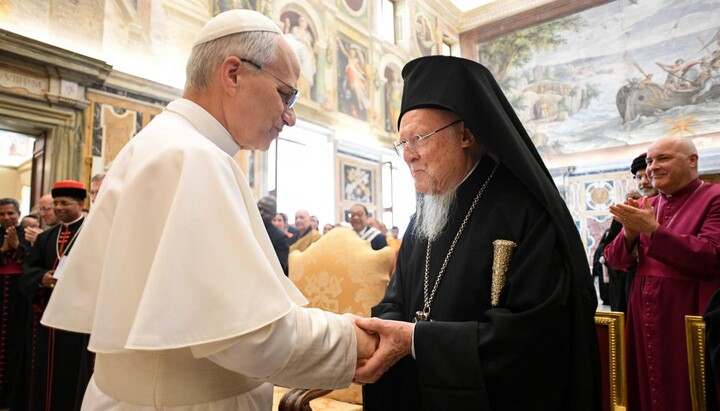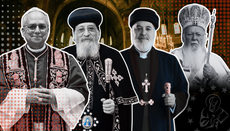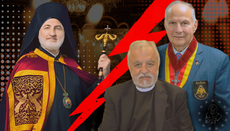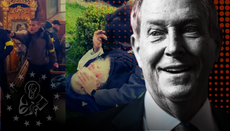The Primacy of God

Calling for a recovery of the sacred in the West, Pope Leo XIV looks East.
‘The Center is God’
I’m sure most of you have heard that Pope Leo XIV recently held a “Jubilee of Oriental Churches” (which, by the way, is an amazing combination of words). During his address, Leo declared:
The Church needs you. The contribution that the Christian East can offer us today is immense! We have great need to recover the sense of mystery that remains alive in your liturgies, liturgies that engage the human person in his or her entirety, that sing of the beauty of salvation and evoke a sense of wonder at how God’s majesty embraces our human frailty!
It is likewise important to rediscover, especially in the Christian West, a sense of the primacy of God, the importance of mystagogy and the values so typical of Eastern spirituality: constant intercession, penance, fasting, and weeping for one’s own sins and for those of all humanity (penthos)! It is vital, then, that you preserve your traditions without attenuating them, for the sake perhaps of practicality or convenience, lest they be corrupted by the mentality of consumerism and utilitarianism.
This reminds me of a certain statement that Pope Francis once made:
In the Orthodox Churches they preserve that pristine liturgy. So beautiful. We have lost a bit the sense of adoration. They preserve it. They praise God, they adore God, singing. Time stops. The center is God. . . . Once, speaking about the western Church, of western Europe, above all the grown-up Church, they told me this phrase: Lux ex oriente, ex occidente luxus. [“Light comes from the East, luxury from the West.”] Consumerism, well-being, have done much harm. Instead, you preserve this beauty of God at the center, the point of reference. When reading Dostoyevsky, I believe that for all of us he must be an author to read and reread, because he has wisdom. One perceives the Russian soul, the Eastern soul. It is something that will do us all good. We need this renewal, this fresh air from the East, of this light from the Orient. . . . Too often, the luxus of the West causes us to lose the horizon.
Francis made this statement in July of 2013, about four months after his election. He said that, in the Eastern Church, “the center is God.” Now we hear Leo, less than a month after his election, saying that the Christian East has maintained “the primacy of God.”
It’s interesting that both popes made virtually identical comparisons so early in their papacies. Maybe it’s because both men, before their election, served as diocesan bishops in South America—an incredible part of the world, but one that is very much part of the Christian West.
Maybe, as they assumed leadership of the global Catholic Church, they also began to take a more global view of the Christian Faith. And, in doing so, they were both struck by the “theocentric” nature of Eastern Christianity, compared to the more “anthropocentric” nature of Western Christianity.
At the risk of seeming ungracious, I would like to offer a few thoughts—from an Orthodox perspective—on why the Eastern Church has retained the theocentric perspective which has been lost in the West.
The Filioque
As you all know, the Great Schism of 1054 was provoked mainly by Rome’s addition of a new clause to the Symbol of Faith (also known as the Nicene-Constantinopolitan Creed): the filioque. This addition was rejected by the Eastern patriarchs of Constantinople, Alexandria, Antioch, and Jerusalem.
The Eastern patriarchs pointed out that the Symbol of Faith had been drafted and ratified by the First and Second Ecumenical Councils. No one bishop—not even the Pope—could modify its text unilaterally. Besides, the Fourth and Eight Ecumenical Councils had declared that no further additions could be made to the Creed.
The Orthodox disputed the substance of the filioque clause as well. Christ Himself said: “But when the Helper comes, whom I shall send to you from the Father, the Spirit of truth who proceeds from the Father, He will testify of Me” (John 15:26).
This is why the Fathers of the Second Ecumenical Council, in the original version of the Creed, said: “And in the Holy Spirit, the Lord, the Giver of Life, who proceeds from the Father, who with the Father and the Son is worshiped and glorified.” They limited their confession to the words used by Christ Himself.
Rome, of course, did not contest Christ’s explication. They did not use a different version of John’s Gospel. But they argued that, by studying different passages of Scripture and the writings of certain Church Fathers, we may conclude (to use the language of Florence) that the Holy Spirit “is eternally from the Father and the Son, and has his essence and his subsistent being from the Father together with the Son, and proceeds from both eternally as from one principle and a single spiration.”
The Orthodox contest this reading of Scripture and the Fathers, as we contest the ability of the Pope—or any bishop—to modify the Creed unilaterally. We are no less alarmed, however, by the idea of using mere logic to “infer” Divine Truths which have not been clearly revealed by Christ and the Apostles. From the Orthodox perspective, Rome was placing human reason on the same epistemological tier as Divine Revelation. This is why Saint Photius of Constantinople condemned the filioque as the “reasonings of the ungodly” and the “depth of impiety.” We see here the seeds of anthropocentrism in the Western Church.
Of course, the Fathers used the language of classical philosophy to define and defend Christian Truth in their own writings and in the dogmatic definitions of the Ecumenical Councils. However, we do not believe that the Fathers would have seen themselves as revealing new truths—nor even of drawing “logical inferences” from Revelation. Rather, as Florovsky explained, “Loyalty to tradition did not prevent the Fathers of the Church from ‘creating new names,’ as Saint Gregory Nazianzens says, when it was necessary for the protection of the unchangeable faith.”
This is a fine line to walk. But the Orthodox may say that it was drawn clearly enough by Saint Irenaeus of Lyon, who wrote in Against Heresies:
Nor will any one of the rulers in the Churches, however highly gifted he may be in point of eloquence, teach doctrines different from these (for no one is greater than the Master); nor, on the other hand, will he who is deficient in power of expression inflict injury on the tradition. For the faith being ever one and the same, neither does one who is able at great length to discourse regarding it, make any addition to it, nor does one, who can say but little diminish it.
Whether Rome had crossed this line in the 11th century is, of course, a hotly contested matter. But the Lord said, “By their fruits you will know them” (Matthew 17:20).
Essence and Energies; the Calendar
In the 14th century, there was another major clash between Catholics and the Orthodox which, for the Orthodox, exemplify Catholicism’s departure from authentic theology.
The dispute began when a Calabrian monk named Barlaam—a student of Western Scholasticism—launched a polemical war against the monks of Mount Athos. The Athonite Fathers claimed that, through the faithful practice of hesychasm, they were able to perceive the Light of Mount Tabor: the pure Uncreated Energy of God.
Barlaam argued that this was impossible. Following the Platonic doctrine of divine simplicity, he argued that (A) God’s energies cannot be distinguished from His essence; (B) God’s essence cannot be perceived by human beings; therefore, (C) mortals cannot perceive the divine energies.
The Orthodox and Athonite position was championed by Gregory Palamas, the Metropolitan of Thessaloniki, who had himself been a monk of the Holy Mountain. It’s impossible to summarize Palamas’s contributions to Orthodox theology in just a few sentences. Among his most important achievements, however, he renewed the complaint that Western theologians had elevated human reason to the level of Holy Scripture.
Gregory Nazianzen said that we must practice theology “in the manner of the Apostles, not that of Aristotle.” Palamas understood—and, indeed, embodied—this principle. The Scholastics, unfortunately, did just the opposite.
Palamas warned that, by confining their theology to the categories of pagan philosophy, Catholics were on the verge of elevating reason above Scripture and Tradition as an epistemological authority. Now we see the seeds of anthropocentrism beginning to blossom.
Here we come to the critical juncture. Meyendorff argues that Palamas saved the Orthodox East from embracing the profane “humanism” which led to the Renaissance, the Reformation, and ultimately the Enlightenment:
Nevertheless there were at stake principles already heralding the advent of the modern world in the dispute between Barlaam and Palamas, and, very often, it was those principles which divided the supporters of Palamas from his adversaries. The humanists, in fact, started from the assumption of a sort of autonomy for human reason, and its independence in relation to a God whom they conceived as some impenetrable and inaccessible Essence. The union of God and man, realized once for all in the person of Christ, and divine actions, active and real, among humanity regenerated by baptism, played no decisive part in their thought. Whereas the hesychasts were defending a conception of Christianity inherited from the Fathers, which left no form of human activity outside the sphere of God's action. The idea of a complete “collaboration” (synergeia) between these two activities was indeed the special message of Palamism. The Orthodox Church, by approving the Palamite doctrine in 1351 and recognizing Gregory Palamas as one of the Fathers, has solemnly condemned the secularism of modern times.
By the 16th century, concerns about secular or humanistic trends in Catholic theology had become a major theme in Orthodox apologetics. For instance, the dating of Easter was fixed by the First Ecumenical Council imn A.D. 325. At the time, their calculation was made using the Julian Calendar. However, in 1582, Pope Gregory XIII issued his new liturgical calendar—now known as the Gregorian Calendar, which he held to be more scientifically accurate. Gregory wrote to the Orthodox patriarchs inviting them to adopt his new calendar. Patriarch Joachim V of Antioch commissioned a reply from his disciple Metropolitan Athanasius al-Marmariti ibn-al Mujalla, who wrote to Pope Gregory:
Our community, our bishops, our kings and all our people, scattered in the four cardinal directions—Greeks, Russians, Georgians, Vlachs, Serbs, Moldovans, Turks, Arabs, and others . . . from the time of the Holy Apostles and God-bearing fathers of the Seven Ecumenical Councils down to this day recognize one faith, one confession, one Church, and one baptism . . . and all our nations agree in the four corners of the inhabited world with one word and one affair . . . and we did not receive the confession and the holy tradition which is in our hands . . . from unknown people, like other, foreign communities.
But we pray with the Holy Apostles and the 318 fathers [of the Council of Nicaea] whose signs and miracles shine forth from them manifestly. And so how can we change the tradition of such holy fathers and follow after unknown people who have no other trade but to observe the stars and examine the sky?
As with the filioque, we see that there are really two complaints here. (1) The dating of Easter—like the text of the Creed—had been established by an Ecumenical Council. How, then, could it be modified unilaterally by the Pope? (2) Why should the Church prefer “scientific accuracy” to the longstanding custom of the Apostolic Church?
One can debate the merits of Athanasius second argument. The main point is this: By the sixteenth century, Orthodox bishops and theologians saw Rome has having given itself over completely to rationalism. What’s equally noteworthy is that the papacy serves as the “trellis” upon which the anthropocentric worldview grows.
‘I Am the Church’
As we have said, the Orthodox feel that we can trace a fairly straight line from Scholasticism to Humanism, Protestantism, and Liberalism. Now, having looked at certain specific developments which directly involve the Orthodox Church, we have to zoom out and take a “meta” view of Western theological history.
- Scholastic theologians become over-reliant upon the methods and concepts of classical philosophy. For instance, we have Aquinas citing pagan philosophers such as Aristotle (“the Philosopher”) and Plato as authorities on God’s nature.
- The elevated status of human reason—including the unillumined minds of the ancient pagans—leads to the Humanism of the Renaissance.
- Protestantism emerges as a reaction against Humanism. Many Protestants use the methods and concepts of Scholasticism against Catholic authorities. For instance, Luther is a disciple of William of Ockham: a Scholastic philosopher whose thought, though controversial, was never condemned by Rome.
- In the parts of Europe that remain Catholic, the authority of the Church is considerably weakened—not only by Rome’s failure to contain the Reformation, but also by the still-growing interest in pagan philosophy. Thus, the Enlightenment is born.
The Enlightenment marks the final victory of anthropocentrism over theocentrism in the West. This is the point at which an explicitly secular worldview begins to emerge.
After a certain point, the papacy positions itself as the great bulwark against the dissolution of the Western Church—the staunch foe of both Protestantism and Liberalism. This effort reaches its apex in the person of Pope Pius IX, who ratified both the Syllabus of Errors and Pastor Aeternus. This has led many Catholics to form, in their own minds, a strong association between the tradition and the papacy.
This association has been challenged by every bishop of Rome since the Second Vatican Council. Yet it doesn’t stand up to any amount of historical inquiry, either.
For instance, the filioque was first added to the Nicene Creed by a local council in Spain in the 5th century to combat Arianism, which survived among the Goths and Lombards for a couple of centuries following Nicaea. However, Arianism was stamped out by the 7th century. Why did the Pope press this modification to the Creed in four hundred years later, against the rulings of two Ecumenical Councils and the protests of his fellow patriarchs?
The real answer has to do with the rivalry between Franks and Byzantines. The Catholic Church’s official reasoning, however, is essentially: “The pope liked it better that way, and we have to do what the pope says.”
The Great Schism occurred because the Eastern patriarchs would not allow the Pope to modify the Creed on a whim. Then, after 1054, the Pope suddenly found himself the sole “Patriarch” of his own communion. He was, indeed, without equals. Of course, after this point, we see papal authority expand quite rapidly.
From that point on, the whole life of the Catholic Church was increasingly dictated by the Pope. He was free to unilaterally “reform” the Mass. He could ratify or abrogate entire liturgical rites. He could write or remove canons from the Code of Canon Law. He assumed the right to appoint every bishop in the world, and to dismiss them for any reason. He could grant or withdraw autocephaly to or from local churches. He could, if he liked, appoint four patriarchs of Antioch at the same time (and he did!).
This “papalism” reached its summit at the First Vatican Council, which declared that the Pope could infallibly define dogma, and that such “definitions of the Roman Pontiff are of themselves, and not by the consent of the Church, irreformable.” Indeed, there is literally no limit to the Pope’s authority over the Catholic Church. As the current Code of Canon Law declares, “The first see is judged by no one” (c. 1404). So, from the Catholic perspective, Pius IX spoke rightly when he declared: “I am the Tradition. I am the Church.”
So, we may say that, in one sense, the Catholic Church is the most “conservative” element of Western society. But we may say that, in another, it is the most radical. Rome has advanced the anthropocentric principle further than anyone else in the West by declaring a mere mortal to be the head of the Church. This is why Saint Justin Popovich has declared: “In the kingdom of humanism the place of the God-Man has been usurped by the Vicarus Christi, and the God-Man has thus been exiled to Heaven.”
Again, I offer this reflection now because the Pope—by all accounts a good and decent man—innocently observed that the Christian West has lost the “primacy of God.” He seems to have noticed, as did his predecessor, that in the East, “the center is God.”
But then who, in the West, is at the center? Man. And who holds primacy in this anthropocentric Church? The Pope himself.
Pope Leo has said, “It is vital, then, that you [Eastern Christians] preserve your traditions without attenuating them.” The Orthodox would humbly remind His Holiness: The filioque is no more a part of the Western tradition than it is the Eastern. Papalism is no more a part of the Western tradition than it is the Eastern. The theocentric vision of the Eastern Church also belongs to the West by right. It is our birthright. Holy Orthodoxy is our patronage. Claim it!
Leo has it within his power to return the Roman Church to its Apostolic and Patristic roots. It could, once again, be the Church of Leo the Great, Gregory the Great, Vincent of Lérins, John Cassian, Cyprian of Carthage, Irenaeus of Lyons, Ambros of Milan, and—above all—the blessed Augustine, whom Pope Leo loves, and who said:
Therefore Peter is from Petra, not Petra from Peter; as Christ is not named for the Christians, but Christians for Christ. “You are Peter,” He said, “and upon this Rock which you have confessed—upon this Rock which you have recognized, saying: ‘You are the Christ, the Son of the living God’—I will build my Church, that is, upon Myself, the Son of the Living God. I will build you upon Me, not Me upon you.”
Amen! The Rock upon which Christ built His Church is the confession of Saint Peter. The Rock is Christ Himself. This is the “primacy of God.” It’s the Faith of the Orthodox Church. It was the faith of the Roman Church. It could be again, if Pope Leo so chose. May it please God!
Originally posted to Michael's Substack, Yankee Athonite









